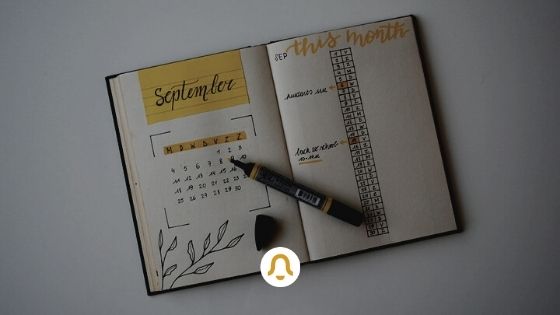An idea born from the mind of Ryder Carroll which is not only a new and useful organizational tool, but a real investment in ourselves capable of improving the quality of our life
The bullet journal is a creative work organization technique, nothing more and nothing less, but its fans are also keen to underline the usefulness of this tool in revolutionizing our habits. Thanks to the bullet journal it is possible to avoid having a thousand notebooks to organize and monitor every aspect of our life: work, shopping list, personal resolutions and so on. In the same way, it will no longer be necessary to hang colored post-it notes left and right without criteria. The most important consequence of this method is that it helps not to accumulate things to do and consequently find time for everything that interests us. It creates order in our head, helps to focus and eliminates stress and chaos. And in an analog way!
The bullet journal is an idea born from the mind of Ryder Carroll , a 40-year-old digital designer, born in Vienna to a couple of American teachers, who suffered from attention deficit disorder. To pass his university exams, he took notes in several notebooks where he also wrote down his thoughts. In 2013, when he had already started working, he had managed to find a way to organise himself using a single notebook. Satisfied with the result, he decided to open a website to explain his new method in a video: the “bullet journal” was born, called bujo in short, which derives from bullet point and suggests an idea of speed since bullet in English means bullet. Of course, the video went viral.
Today bujo has definitely grown: it has its own vocabulary, various influencers and 5.6 million posts on Instagram. Everyone can build their own notebook, and there are several theories as to what the perfect one should look like: hardcover? Soft? Should writing have a purely functional role or is it better to be decorative? “Thanks to a notebook, a pen and the recovery, in the height of the digital era, of handwriting, the bullet journal helps to concentrate, organise and improve the organisation of daily time. Its strong point in the long run is that it allows us to think about ourselves. Stopping to recap, gather energy and resume walking is at least as necessary as the homework and work we do every day, ”says Mario Tascón, founding partner of the consulting firm Prodigioso Volcán which organizes workshops on the bullet journal.
How to make a bullet journal in five steps
How can we start organising our life with this method? Here are the five tips summarised by Ryder Carroll himself :
1) The first thing to do is to get a notebook , if possible an elegant and resistant one because it will accompany us everywhere, and create an index on the first two pages to help us then easily find everything we will write down. The next two pages should be titled ” Future Register ” and divided by months because in practice it is a long-term calendar. Number the pages and then start writing a daily, monthly and yearly activity log, as well as lists and libraries. To catalog ideas, meetings, events or activities, just to give some examples, we will need to use a series of symbols that make them recognisable as a gender and other useful signs to indicate that we have completed an activity or that we moved it to another section.
2) Set our intentions.It is important to ask yourself a question: why did we decide to watch the video above, what are each of us looking for? Answering this question means defining our need: do we intend to be more productive, more creative? We have to write down what we want to get out of our darkness and make sure it is a real need. We can, and should, change our intention whenever we feel the need, so we don’t have to think about it too much. It is fun to see our purposes change over time, and therefore our intentions do not need to be successful. The bullet journal philosophy is very concrete: it is based on doing and focuses on the process. Our intentions serve to give us a direction, not a destination, ”Carroll points out.
3) Record thoughts related to the focus of our notebook during the day. If we were, for example, using the dark to help us cope with depression, we will write down the things that make us feel good as we experience them. If, on the other hand, we were trying to be more productive, we would write down what needs to be done when it is needed and not in advance. “When starting out, it’s important to get in the habit of capturing our thoughts when they come out. No planning, no models and no imperatives, we just have to capture our thoughts and put them on paper. Let’s be linear. At the beginning we might have the feeling that we are doing little, but in the long run we will understand the difference between doing something instead of nothing, a huge difference certainly ”.
4) Use the notebook according to our concrete needs. “The effectiveness of the bullet journal comes from its adaptability. Its design is modular and allows us to add or remove functions depending on the circumstances. At first, the number of tools available in this method may seem overwhelming, but with practice we come to make a choice and use the right tools for our work. We begin to exploit those most directly necessary and linked to our intention. Once we have captured our thoughts for a while, we will begin to understand exactly what is missing such as categorization or classification. It’s time to add another tool to our kit, first of all the quick log, which will help us inventory our thoughts by sorting them into tasks, events, notes and collections.
5) Focus on what matters . There are many examples of bullet journals, from the most artistic to the minimalist, that can make us believe in the existence of hyper-organized lives, but this is not the purpose. “This method will not make us immune to the chaos of life. If anything, it will help us to accept the mess a little more and learn from it. It is not about achieving perfection, but about having a purpose. It’s designed to help us spend more time on the essentials and less on the things that don’t matter. We do this to pay more attention to our life, one note at a time. That’s how it starts, ” concludes Carroll.
Read More:


